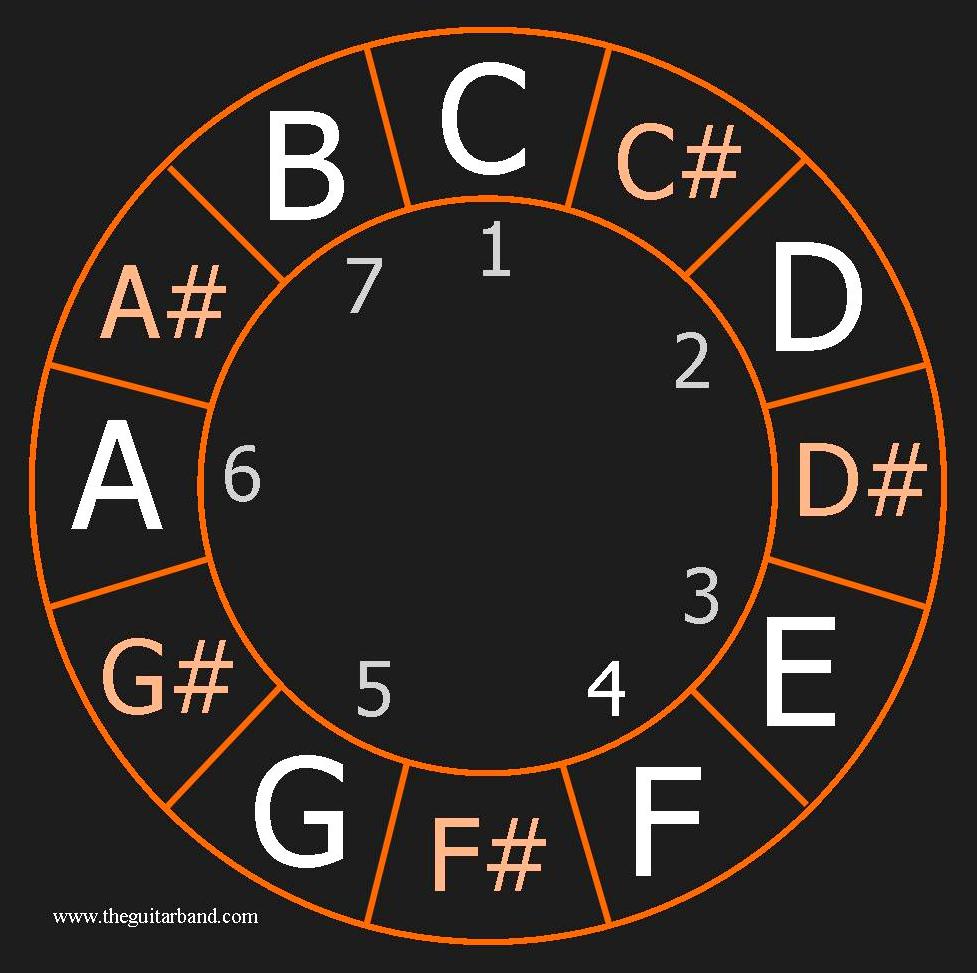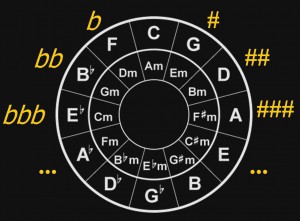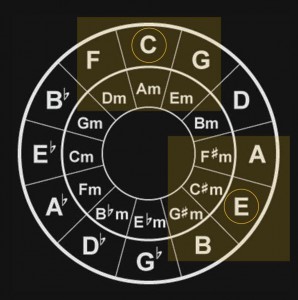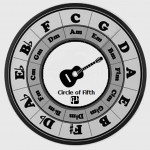The Circle Of Fifths
Easy Learning for Beginners: what it is and what it is for
The Circle of Fifths can help you as a guitarist when you get stuck trying to write a song or stuck trying to figure a song out by ear.
The Circle of Fifths can help you easily find the notes of a Chord, and just about anything else once you get the hang of it.
Circle of Fifths
Start with C and go around the Circle of Fifths. You will notice that since there are twelve notes, they are arranged in the exact same position that the numbers on a clock would be arranged.
The Circle of Fifths is very simple to produce.
- Start with C
- Place the Fifth of C (which is G) Clockwise of it.
- Start with G, and place the Fifth of G (which is D) Clockwise of that. And so on and so on.
Counterclockwise you get automatically the fourth: to the left of C you see F (the fourth of the C major scale).
Somebody use to remember the main notes with a phrase like this:
Father Charlie Goes Down And Eats Breakfast
…or you can download the printable clock at the bottom of this page!
What is its Purpose?
The Circle of Fifth is useful for
- Finding the Chords of a Song
- Finding Notes of a Chord
- Key Change (Transpose)
- Building a Major Scale
- Creating your own song
…and more.
1. Chords
When playing most kinds of music, the most common chords will be the chord of the key you are working in, and the chords on either side of the circle.
For example, if you are playing in the key of C, you’ll likely use F and G as well ( the chords on the sides of C).
The famous song “Cotton Fields” use the chords C, F, G.
Do you want transpose the song, maybe because it is too hard to sing? Let’s sing on A. Watch at the Circle: the new chords are now A, D, E (because D and E are on the sides of A).
2. Notes
Another useful help to find the notes of a chord. If we want the fifth, we already know how to do with this tool, otherwise we should count +7 semitones (and this can lead to errors). If we need the fourth count +5 semitones. Remember the chromatic scale:

Chromatic Scale (This is not the Circle of Fifth)
With the Circle of Fifths, you will not need to count. You can identify notes instantly.
If you want write down the notes of the C Chord: 1st, 3th, 5th. They are C, C+2T, G.
C chord: C, E, G
No shortcut for the third, but not too difficult to find. The fifth is quite far so better look at the circle of fifth. In any case there is a quick way to find the third with the circle of fifth:
3th = 4th b (fourth flat).
The fourth of C (at the left of C on the circle of fifth) is F. The third is the fourth flat, Fb (Fb = E).
To find the Seventh (7b) just 2 steps Counterwise. 7b of the C chord = Bb
Ex.: F7 = F, A (Bbb), C, Eb.
Again, we want to know which is the Fifth Augmented of C (C+), simply: G # (G + 1 semitone)
Therefore the C+ chord (sometime write as Caug) will be composed of C, E, G #.
We can also create songs with the main chord followed by the fourth and fifth, and so on.
3. Key Change
When you want to transpose a song, the tricky part is getting the new notes. If you want 1 Tone down is not too difficult but let’s choose a Key far form the tonic (main key).
A When I was a little bitty baby D A My mama would rock me in the cradle E7 In them old cotton fields back home
Imagine you want to change the Key of Cotton Fields to the key of D. Of course you look at the A major scale and count the distance form A to D, that is 2T+1s (5 semitones) and do the same for all the notes. With the Circle of Fifth can find the note right away, D is near (before) A, G before D, A before E.
If you choose E, just look at the note past A. Very easy, etc.
4. Use the Circle of Fifths to Build Scales
Sometime you read that C has zero sharps, G has one sharp, D has two sharps, etc. (reading clockwise). What this means?
This refer to the Major scale of the note. 
C, Major scale, no sharps. C D E F G A B
G, 1 sharp. G A B C D E F#
D, 2 sharps D E F# G A B C#
A, 3 sharps. E, 4 sharps, etc.
This can be useful to write down the scales.
Example.
Let’s find the Major scale of G (1 sharp).
The sharp is: F#, 1 note Counterwise leaving out the next. This is the scale: G A B C D E F#
Let’s find the Major scale of E (4 sharps).
The sharps are: F C G D, 4 notes Counterwise leaving out the next. This is the scale: E F# G# A B C# D# (write first the diatonic scale E F G A B C D and than put the #).
The Flats.
Don’t worry too much about the Major scales with flats. Guitarists use them rarely.
Just remember that the Major scale of F has 1 flat, Bb, This is the scale: F G A Bb C D E
5. Create Your Song
The chords more frequent are those around the main note:
Try using a combination of them to create your own song!
Minor Chords
Under C you see Am. This is the Relative Minor of C. This means that the Am scale has the same notes of the C Major scale, but obviously starting from A.
This is your “Circle of Fifths Clock”
Is a good idea to print and stick on your wall clock!
The “Circle of Fifths Clock” Printable Version:
Free gift for your desktop: The “Circle of Fifths Wallpaper”

Discover the latest musical instruments on our music website on Amazon!
Explore the latest musical instruments on Amazon music store and support our channel at no extra cost to you! By purchasing any musical instrument through our affiliate link, you not only get top-quality gear but also contribute to our channel's growth and content creation.

 Join our Telegram group: Band in a Box Backing Tracks.
Join our Telegram group: Band in a Box Backing Tracks.
 Join our Facebook group (download/share backing tracks): SGU BackingTracks
Join our Facebook group (download/share backing tracks): SGU BackingTracks







